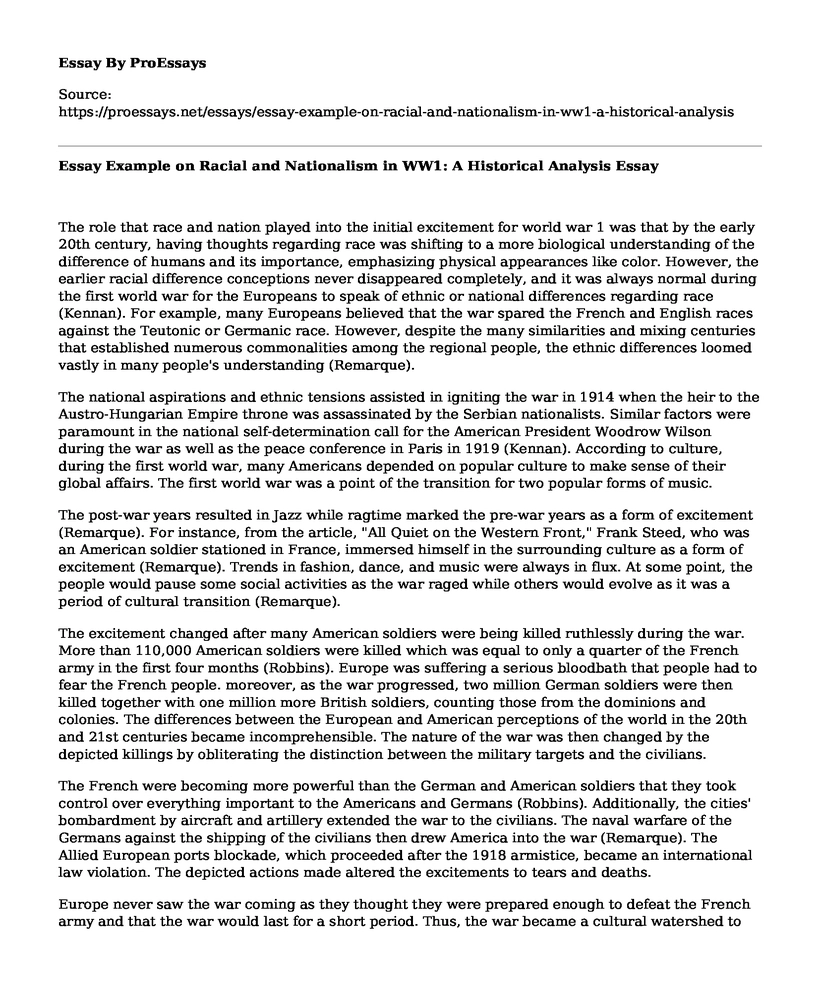The role that race and nation played into the initial excitement for world war 1 was that by the early 20th century, having thoughts regarding race was shifting to a more biological understanding of the difference of humans and its importance, emphasizing physical appearances like color. However, the earlier racial difference conceptions never disappeared completely, and it was always normal during the first world war for the Europeans to speak of ethnic or national differences regarding race (Kennan). For example, many Europeans believed that the war spared the French and English races against the Teutonic or Germanic race. However, despite the many similarities and mixing centuries that established numerous commonalities among the regional people, the ethnic differences loomed vastly in many people's understanding (Remarque).
The national aspirations and ethnic tensions assisted in igniting the war in 1914 when the heir to the Austro-Hungarian Empire throne was assassinated by the Serbian nationalists. Similar factors were paramount in the national self-determination call for the American President Woodrow Wilson during the war as well as the peace conference in Paris in 1919 (Kennan). According to culture, during the first world war, many Americans depended on popular culture to make sense of their global affairs. The first world war was a point of the transition for two popular forms of music.
The post-war years resulted in Jazz while ragtime marked the pre-war years as a form of excitement (Remarque). For instance, from the article, "All Quiet on the Western Front," Frank Steed, who was an American soldier stationed in France, immersed himself in the surrounding culture as a form of excitement (Remarque). Trends in fashion, dance, and music were always in flux. At some point, the people would pause some social activities as the war raged while others would evolve as it was a period of cultural transition (Remarque).
The excitement changed after many American soldiers were being killed ruthlessly during the war. More than 110,000 American soldiers were killed which was equal to only a quarter of the French army in the first four months (Robbins). Europe was suffering a serious bloodbath that people had to fear the French people. moreover, as the war progressed, two million German soldiers were then killed together with one million more British soldiers, counting those from the dominions and colonies. The differences between the European and American perceptions of the world in the 20th and 21st centuries became incomprehensible. The nature of the war was then changed by the depicted killings by obliterating the distinction between the military targets and the civilians.
The French were becoming more powerful than the German and American soldiers that they took control over everything important to the Americans and Germans (Robbins). Additionally, the cities' bombardment by aircraft and artillery extended the war to the civilians. The naval warfare of the Germans against the shipping of the civilians then drew America into the war (Remarque). The Allied European ports blockade, which proceeded after the 1918 armistice, became an international law violation. The depicted actions made altered the excitements to tears and deaths.
Europe never saw the war coming as they thought they were prepared enough to defeat the French army and that the war would last for a short period. Thus, the war became a cultural watershed to every individual as it changed their attitudes towards war. People's ideal of heroes then changed from the bellicose model of the Greek-Roman to more peaceful ones (Kennan).
Works Cited
Kennan, George Frost. The fateful alliance: France, Russia, and the coming of the First World War. Manchester University Press, 1984. ISBN: 0-7190-1707-6
Remarque, Erich Maria. All quiet on the western front. Vol. 68. Bloomsbury Publishing USA, 2004. Retrieved from https://www.raleighcharterhs.org/faculty/sarcaro/eng2docs/AllQuiet/vocab_list_p12.pdf
Robbins, Keith. The First World War. Oxford Paperbacks, 2002. ISBN:0-19-280318-2
Cite this page
Essay Example on Racial and Nationalism in WW1: A Historical Analysis. (2023, Apr 24). Retrieved from https://proessays.net/essays/essay-example-on-racial-and-nationalism-in-ww1-a-historical-analysis
If you are the original author of this essay and no longer wish to have it published on the ProEssays website, please click below to request its removal:
- Detailed Description of Amite: Research Paper
- The Lost Cause, the New South, the Agrarian Revolt Essay
- Teachers Pay and Performance-Based Policies Essay Example
- Essay Example on Immigration in the US: From Reconstruction to Modern Times
- Research Paper on Governance & Politics: A Mutual Relationship
- Essay on Trump's Quest to Restore America's Greatness: 2018 Trade & Manufacturing Policy
- Essay Example on African Americans' Struggle for Equality Post WWII







